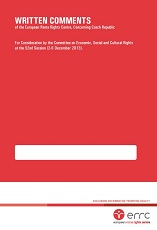WRITTEN COMMENTS OF THE EUROPEAN ROMA RIGHTS CENTRE, CONCERNING ROMANIA (For Consideration by the Committee on Economic, Social and Cultural Rights at the 53rd Session 26-30 May 2014)
WRITTEN COMMENTS OF THE EUROPEAN ROMA RIGHTS CENTRE, CONCERNING ROMANIA (For Consideration by the Committee on Economic, Social and Cultural Rights at the 53rd Session 26-30 May 2014)
Author(s): Author Not Specified
Subject(s): Law, Constitution, Jurisprudence, Civil Law, International Law, Human Rights and Humanitarian Law, Welfare systems, Evaluation research, Health and medicine and law, Ethnic Minorities Studies
Published by: European Roma Rights Center
Keywords: Romania; Roma; human rights; judiciary; civil procedure code; forced evictions; health care; evaluation;
Summary/Abstract: According to current unofficial estimates Roma in Romania make up approximately 9% of the population (approximately 1,700,000). However, a verified and accurate count remains elusive. According to the final results of the 2011 Census of the Population and Households published on 4 July 2013 by the National Statistics Institute, Romania had a total population of 20.12 million. Among the 18.88 million respondents who self-reported their ethnicity, 621,600 were Roma (3.3%, an increase from 2.46% in the 2002 census). The ERRC’s research on Roma in Romania shows that Roma continue facing discrimination in all areas of social life, including housing, education, employment and health. In December 2011, the Romanian Government adopted the Strategy for the Inclusion of the Romanian Citizens belonging to Roma minority for the period 2012 – 2020 in the context of the European Commission’s Communication on adopting an EU Framework for National Roma Integration Strategies up to 2020 (hereinafter the Strategy). The Strategy focuses on four areas, namely access to housing, access to health, education and employment. However, it has been highly criticised by NGOs, which were not consulted prior to its adoption. Moreover, the Strategy lacks clear indicators on measuring its impact, reducing the possibility of effective implementation and of improving Roma inclusion policies through lessons learnt.
Series: Papers submitted to OHCR and related Commissions
- Page Count: 8
- Publication Year: 2014
- Language: English
- Content File-PDF
- Introduction

